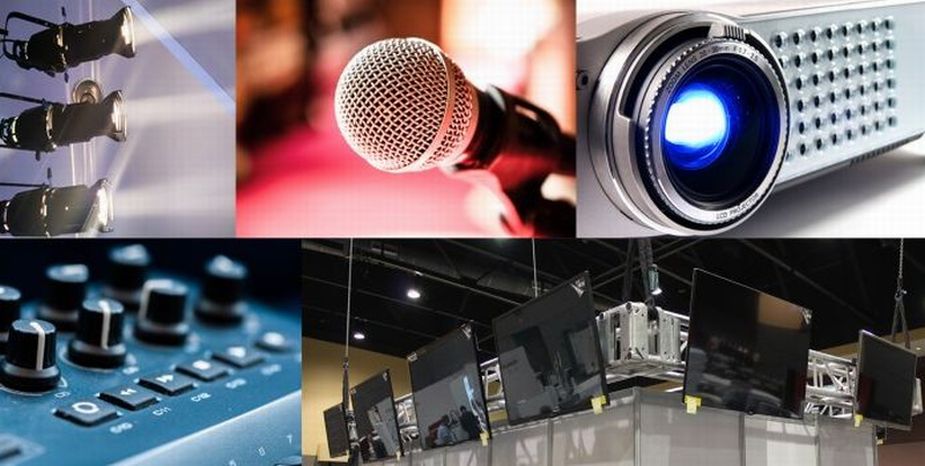Why audio visual charlotte nc is the foundation of seamless events
Wiki Article
Comprehending the Inclusion of Audio Visual Technology in Today's Educational Environments
The integration of audio-visual modern technology in academic setups has changed the mentor and finding out procedure. Educators now have accessibility to tools that accommodate various finding out styles, enhancing pupil engagement and cooperation. Nevertheless, the unification of these innovations offers both opportunities and obstacles. Recognizing exactly how to effectively carry out these devices is essential. What approaches can teachers use to make the most of the advantages of audio-visual technology in their class?The Advancement of Audio-Visual Technology in Education
As educational demands advanced over the years, audio-visual innovation undertook considerable makeovers that reshaped the understanding environment. Devices such as film projectors and slide shows were the key means of integrating visual components right into class. These very early technologies supplied instructors with the capacity to present details dynamically, yet they were limited in ease of access and interactivity.With the arrival of videotape recorder in the 1970s, classrooms began to include recorded lessons, expanding the scope of academic resources. The introduction of desktop computers in the 1980s further reinvented this landscape, allowing for the creation of multimedia presentations and interactive discovering experiences.
The surge of the internet in the 1990s marked a turning point, making it possible for real-time access to a wide range of audio-visual materials. Today, digital tools such as interactive white boards and online knowing systems continue to enhance the educational experience, promoting interaction and cooperation among learners.
Benefits of Audio-Visual Devices for Diverse Understanding Styles
Audio-visual tools play an essential role in providing to varied learning styles by enhancing aesthetic learning and boosting acoustic involvement. By including images, video clips, and audio, these modern technologies develop an even more comprehensive academic atmosphere. This diverse technique enables educators to address the diverse preferences and needs of trainees efficiently.Enhancing Visual Understanding
Interaction in the understanding process is considerably boosted with the usage of audio-visual tools, providing to numerous discovering styles. These devices, such as video clips, infographics, and interactive presentations, give visual stimuli that assist understanding and retention. Visual students, specifically, take advantage of the incorporation of photos and animations, which can streamline complicated ideas and improve understanding. Furthermore, audio-visual resources can illustrate real-world applications, making finding out more appropriate and engaging. By incorporating color, activity, and sound, educators can develop a dynamic understanding environment that records pupils' interest and promotes deeper cognitive links. Ultimately, the critical use audio-visual modern technology not only sustains aesthetic discovering but likewise enriches the general academic experience for varied learners.Improving Auditory Interaction
A significant advantage of integrating audio-visual tools in education and learning is their ability to improve acoustic involvement amongst pupils. These tools, which encompass multimedia discussions, podcasts, and interactive audio aspects, deal with different finding out designs, specifically profiting auditory learners (audio visual charlotte nc). By integrating sound and narration, teachers can develop immersive experiences that capture pupils' attention and reinforce understanding. This involvement is necessary, as it fosters a deeper understanding of the product and promotes retention. Furthermore, audio-visual devices can facilitate collaborative knowing environments, urging pupils to take part in conversations and share their understandings. Inevitably, the unification of audio-visual modern technology not just supports acoustic involvement but additionally enhances the general educational experience, making learning more vibrant and effective for all studentsEnhancing Engagement Through Interactive Understanding

Gamification aspects, such as tests and simulations, can boost motivation and retention, making finding out a lot more enjoyable and efficient. These strategies not only boost cognitive interaction yet also accommodate diverse discovering styles, making certain that all students can take part meaningfully. Therefore, interactive learning atmospheres promote a feeling of community and belonging, eventually bring about improved academic results. Via the integration of audio visual modern technology, educators can transform standard class into dynamic rooms where trainees grow and proactively shape their academic journeys.
Connecting Concept and Experiment Multimedia Resources
Multimedia resources serve as an important link between theoretical ideas and functional application in instructional setups. By enhancing engagement, helping with collaborative learning experiences, and sustaining varied learning designs, these tools create a more inclusive and dynamic knowing atmosphere - audio visual charlotte nc. This technique not just fosters deeper understanding yet also prepares trainees for real-world obstacles
Enhancing Engagement Through Multimedia
Engagement in academic settings significantly enhances when teachers integrate multimedia resources into their training strategies. Making use of video clips, podcasts, and interactive discussions improves the discovering experience, allowing pupils to connect with the material on multiple degrees. Multimedia resources deal with numerous finding out styles, providing aesthetic, auditory, and kinesthetic stimuli that can hold students' attention better than typical lecture techniques. In addition, these resources can simplify complicated concepts, making them extra obtainable and unforgettable. By incorporating multimedia, teachers can develop a dynamic class atmosphere that fosters interest and encourages learners. Eventually, the calculated use audio-visual innovation offers to bridge the space in between theoretical understanding and sensible application, improving the educational experience for both trainers and pupils.Helping With Collaborative Understanding Experiences
Many researches indicate that collaborative understanding experiences substantially enhance trainee end results when integrated with multimedia resources. Multimedia devices facilitate communication amongst students, enabling them to participate in problem-solving and important thinking jointly. By utilizing video clip conferencing, joint systems, and interactive discussions, instructors develop atmospheres helpful to teamwork and shared knowing. These modern technologies enable students to interact their concepts successfully and obtain immediate feedback, fostering a much deeper understanding of the subject issue. In enhancement, multimedia sources can offer complex concepts in even more absorbable layouts, advertising conversation and collaboration. Therefore, the combination of collaborative learning and audio-visual modern technology not just enriches the educational experience yet also prepares trainees for real-world synergy dynamics, emphasizing the value of collaboration and collective expertise construction.Sustaining Diverse Discovering Styles
While traditional mentor approaches typically satisfy a restricted variety of learning preferences, the assimilation of audio-visual technology offers a much more comprehensive method to education. By employing multimedia resources such as video clips, interactive simulations, and digital discussions, teachers can address numerous discovering designs, including aesthetic, auditory, and kinesthetic. This adaptability enables separated instruction, enabling pupils to engage with web content in methods that reverberate with their private preferences. In addition, audio-visual tools can promote much deeper understanding by offering numerous representations of complex principles. As a result, trainees who may battle with traditional methods can discover alternative pathways to success, promoting a more fair learning setting that supports scholastic achievement for all students.Obstacles in Carrying Out Audio-Visual Technology
Although audio-visual modern technology holds fantastic promise for boosting educational experiences, its application often comes across considerable obstacles. One key issue is the economic burden connected with investing in and maintaining such equipment, which can strain budget plans, specifically in underfunded organizations. In addition, inadequate training for instructors can hinder efficient assimilation, leaving them ill-prepared to make use of the modern technology totally. Technical problems, such as software program breakdowns and compatibility troubles, might additionally interrupt lessons and frustrate both instructors and students. Varying levels of student accessibility to modern technology outside the class can develop variations in discovering chances. The possibility for over-reliance on modern technology may detract from important teaching methods, inevitably restricting the academic experience. Resolving these difficulties requires a comprehensive approach, consisting of appropriate funding, specialist advancement, and equitable accessibility to resources, to assure that audio-visual innovation can be leveraged successfully in today's academic settings.Best Practices for Integrating Innovation in the Classroom

Additionally, promoting an interactive atmosphere via collaborative tools encourages student interaction and involvement. Using diverse audio-visual resources accommodates various finding out designs, accommodating aesthetic, acoustic, and kinesthetic learners. On a regular basis evaluating the effect of innovation on student learning helps teachers refine their methods and adjust to altering demands. Lastly, entailing pupils in the selection of innovation advertises possession and inspiration. By adhering to these ideal techniques, instructors can produce a dynamic class environment that successfully integrates technology and boosts the instructional experience for all trainees.
The Future of Audio-Visual Innovation in Education
As classrooms significantly accept modern technology, the landscape of audio-visual devices in education and learning remains to evolve (audio visual charlotte nc). Future advancements are anticipated to concentrate on better interactivity and customization, permitting educators to tailor finding out experiences to individual pupil demands. Technologies such as enhanced fact (AR) and virtual truth (VR) will likely give immersive understanding environments, boosting student involvement and understanding
Furthermore, expert system (AI) is positioned to play a considerable role in audio-visual innovation by offering real-time comments and flexible knowing paths. This combination might help instructors identify and attend to pupil challenges better. Cloud-based platforms will assist in less complicated access to sources and collaboration among trainees and instructors, no matter of area.
In enhancement to these technological developments, specialist development for educators will certainly be crucial, ensuring they are furnished to make use of these tools properly. On the whole, the future of audio-visual technology in education promises to create more dynamic, inclusive, and impactful learning experiences.
Regularly Asked Questions
Just How Can Teachers Select the Right Audio-Visual Tools for Their Classrooms?
Selecting proper audio-visual devices calls for educators to assess their academic goals, think about pupil demands, examine available technology, and look for referrals from peers or professionals, making certain tools effectively improve knowing and engagement within their specific class atmosphere.What Budget plan Factors to consider Are There for Applying Audio-Visual Modern Technology?
Spending plan considerations for applying audio-visual modern technology include initial purchase prices, upkeep expenses, training for staff, and possible software application licensing fees. In addition, long-lasting investment in updates and more info substitutes must likewise be factored right into monetary planning.Exist Particular Training Resources for Educators on Audio-Visual Equipment?
Many establishments use training resources for educators on audio-visual devices, including on-line courses, workshops, and educational guides. These sources aim to improve instructors' skills and self-confidence in efficiently incorporating innovation right into their teaching methods.Just how Do We Determine the Efficiency of Audio-Visual Modern Technology in Knowing?
Gauging the effectiveness of audio-visual modern technology in learning includes reviewing student engagement, understanding, retention rates, and general academic performance. Studies, analyses, and observational research studies can give valuable insights into its influence on educational results.What Are Usual Mistaken Beliefs Concerning Audio-Visual Technology in Education?
Typical false impressions about audio-visual innovation in education consist of the idea that it guarantees interaction and discovering end results, in addition to the presumption that all students benefit equally, ignoring specific understanding preferences and needs.Report this wiki page